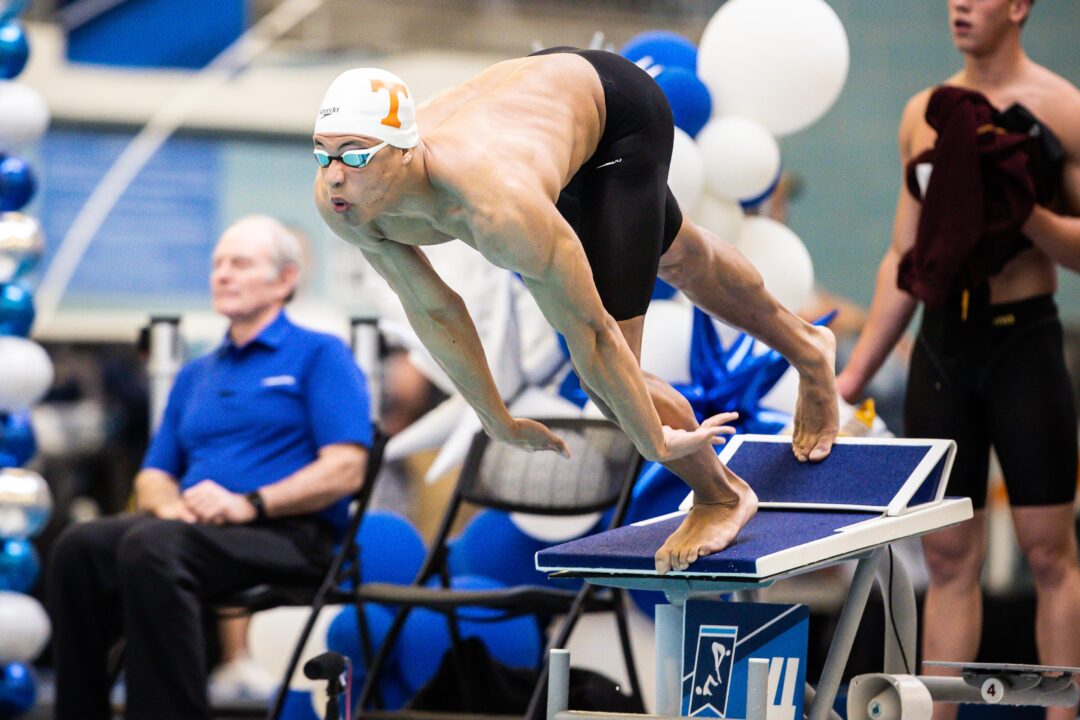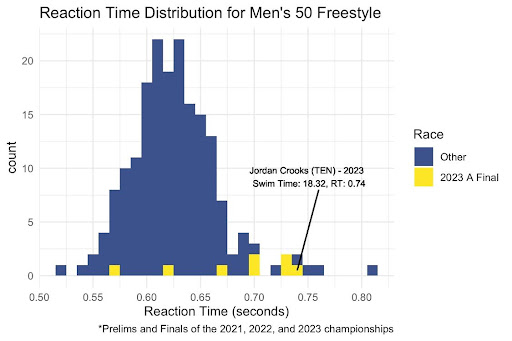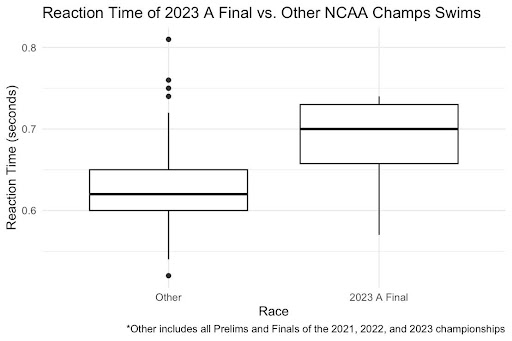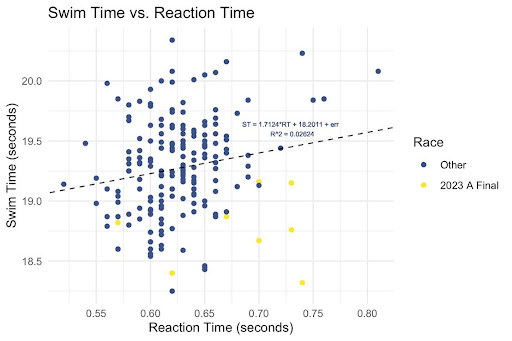Courtesy: Steve Gambino.
The Men’s 50-yard freestyle at the NCAA Championships is the fastest, and arguably most intense race to watch in all of swimming – a true “blink and you’ll miss it” kind of event. It’s a race that necessitates near perfection, where even the smallest mistake can be the difference between a win or a loss, or a record broken versus a time forgotten. The anticipation for this race is high. Even just streaming the meet from home, you can feel the tension build in the moments leading up to the buzzer. The walkout flanked by pyrotechnics, the pre-race rituals, and the swagger and prowess of the athletes all contributing to the suspense, which builds as the camera cuts from one swimmer to the next, some rolling their broad shoulders back, some shaking out the powerful yet loose muscles of their arms, but all focused intently on the race ahead. Our attention is completely captured as they make their slow, powerful ascension onto their platforms. Over the broadcast commentary, Rowdy Gaines notes quietly, ‘watch the start,’ as if it was even possible that any swim fan could physically have forced their eyes toward anything else in that moment. Then finally – ‘take your mark’ – with that last breath as the competitors lean down to grip the edge of the blocks, we lean forwards gripping the edge of our seats before…a bit of a wait?
That’s how it went this time at least. With Tennesee’s Jordan Crooks taking an extra moment to set, the officials had to hold the start just a little bit longer than usual, and we were all forced to hold our breaths, waiting. But then they’re off! Mostly…
As Rowdy immediately noted during the broadcast, “Crooks was dead-last off the blocks!” Going even further to state, “I mean, he was terrible.” (Is it just me or can you also hear his voice in your head as you read this!?). And he wasn’t wrong. It would have been difficult not to notice how far Crooks seemed to fall behind off the start. Even by the halfway point, when he touched behind Josh Liendo, this felt like it could have been devastating for the athlete who was arguably the favorite for the win.
Fortunately for him though, this was not a case where falling a bit short of perfection cost him that win – he was able to make an impressive comeback on the second 25. Costing a record though? Probably not, but that’s tougher to tell – I suppose you never know for sure how things might have played out.
While in retrospect this can all feel a bit dramatic, personally, I didn’t think twice about it in the moment. Maybe I’m a bit biased after watching thousands of starts go off at age group meets, where the slightly longer delay between “take your mark’”and the buzzer is a much more common occurrence, but it didn’t really phase me at the time. However, based on the commentary about the race, I seem to be the odd one out here, and admittedly, it does feel a bit long when rewatching the race back. So, it got me curious.
How much did this affect the race? Just how slow was his start, or all of the starts in this final heat more generally? How much of a difference did this delay make toward their overall performances and how much does reaction time really matter overall? Let’s take a quick look at how the numbers shake out.
The Data
For this analysis, I’ll be using results of the Men’s 50-yard freestyle from the past three NCAA championship meets (2021, 2022, 2023) including both prelims and finals swims. I’ve posted the data set here. It includes each swim with the reaction time, splits, and final times, etc. Results for DQs are included in the data set, but will be removed for all analysis below.
The 2023 Championship Final
First, let’s orient ourselves with some of the data/results so we can compare. What does a typical reaction time look like in the Men’s 50 free? Across the last three NCAA championships, there have been 186 swims in the event with an average reaction time of 0.627 seconds and a median of 0.62. The full distribution is plotted below.
We can note that the majority of the reaction times seem to collect between about 0.57 and 0.67 seconds (about 86.6% of them). However, there are a few outliers. On the faster end, Bruno Blaskovic of Indiana University, who placed 13th in 2022, got off the block in a blazing 0.52 seconds – the fastest I’ve personally seen looking across ISL, Olympic, and USA National competitions from the past few years. Even with this exceptionally fast reaction, Bruno interestingly didn’t break the 19-second barrier on this swim (though he had previously). On the slower end, reactions occurred as high as 0.81 from Dylan Hawk of California in 2022, where he placed 52nd with a time of 20.08.
So, where does Jordan Crooks‘ start (and the entire field) stack up? Here are the results.
| Table 1: 2023 NCAA Men’s 50 Freestyle Final Results | ||||
| Place | Last Name | First Name | Reaction Time | Final Time |
| 1 | Crooks | Jordan | 0.74 | 18.32 |
| 2 | Liendo | Josh | 0.62 | 18.40 |
| 3 | Seeliger | Bjorn | 0.70 | 18.67 |
| 4 | Curry | Brooks | 0.73 | 18.76 |
| 5 | Ramadan | Youssef | 0.57 | 18.82 |
| 6 | Alexy | Jack | 0.67 | 18.87 |
| 7 | Dolan | Jack | 0.73 | 19.15 |
| 8 | Santos | Guilherme | 0.70 | 19.16 |
Crooks did indeed have the slowest start amongst the final, getting off in 0.74 seconds. However, he wasn’t the only one to get off slowly. Many of his competitors in this heat, Seeliger (0.70), Curry (0.73), Dolan (0.73), and Santos (0.70), were unusually slow too, as all but two swimmers in this heat were far slower than average. Modifying our distribution below to highlight the athletes from this final in yellow, shows that they tend to fall farther to the right of the distribution than other swims across these three meets. For determining the cause of this discrepancy, I’ll leave that up to you.
Just how significant is this difference though? Well, it’s at least statistically significant. If we run a t-test comparing the reaction times of this heat with the remainder of the performances across the past three NCAA championships, we get a p-value of about 0.02. In other words, there is only about a 2% likelihood that this heat’s slower reactions could have been a fluke of chance, rather than being truly, notably slower. This difference can be observed visually by the following boxplot too.
For Jordan more specifically, we note that his reaction here was slower than 98% of all others in the data set. To have that kind of start, then still manage to win the championship, is certainly remarkable. It also begs the question: then how much does reaction time matter anyway?
Reaction Time vs. Swim Time
Based on this swim, it may not appear to matter much, but anecdotally considering some other races, it might appear to be quite a lot. A few recent races that came to mind right away: (1) Gretchen Walsh’s loss to Maggie MacNeil just a week earlier at the 2023 Women’s NCAA Championships, (2) Michael Andrew’s silver medal, losing to Ben Proud, at the 2022 World Championships, and (3) Michael Andrew’s 4th place finish at the Tokyo Olympics. I’m sure there are others that you may think of too, but what connects all of these races is that the difference between reaction times of the competitors was less than or equal to the difference between their final times. In other words, had Gretchen and Michael gotten off the blocks as fast as their opponents, they would have tied or overtaken them for a higher place on the podium.
| Table 2: 3 Examples of Reaction time Margins were greater than Final Time Margins | ||||||||
| Meet | Athlete | Reaction Time | Final Time | Competitor | Reaction Time | Final Time | RT Diff. | FT Diff. |
| 2023 Women’s NCAA Championships6 | Gretchen Walsh | 0.74 | 20.85 | Maggie MacNeil | 0.64 | 20.79 | 0.10 | 0.06 |
| 2022 World Championships7 | Michael Andrew | 0.66 | 21.41 | Ben Proud | 0.57 | 21.32 | 0.09 | 0.09 |
| 2021 Tokyo Olympics8 | Michael Andrew | 0.66 | 21.60 | Florent Manadou | 0.61 | 21.55 | 0.05 | 0.05 |
To me, these specific cases feel instinctually compelling and tempt me to want to potentially overvalue the contribution of the reaction time toward winning the race. I think this requires a bit more diligence though, so let’s explore whether the numbers actually bear this out.
Statistically, the contribution of reaction time does not seem as impactful as instinct would suggest. A linear regression of these competitors’ swim times by their reaction times identifies a statistically significant relationship (p = 0.0154), but provides a remarkably low correlation of only 0.02624.
In other words, there is a relationship between reaction time and swim time, but that on its own does not say much, and in fact, should be expected. The reaction time is part of the swim, so it would be unusual if we didn’t see at least some connection between these two values. What is more relevant is how much of a relationship there is. Specifically, how much do the differences in reaction times determine the differences in swim times and therefore event results? This is where the low correlation becomes especially important.
On average, the reaction time makes up about 3.2% of a final race time, proportionately (dividing reaction time by total time). What our low correlation is demonstrating is that the variance of reaction times only determines about 2.6% of the variance in final times. While that isn’t nothing, especially for a race like a 50 freestyle, where again, anything shy of perfection can be extremely costly, it’s also not a dramatic and definitive sign that reaction times are hugely or disproportionately important to the overall swim. The analysis doesn’t suggest that a swimmer’s overall performance is “highly correlated” with their reaction time. In fact, it appears to be the opposite. Jordan’s race bears this out, since despite a “terrible” start, he still won. And more broadly, as seen in the scatter plot below, there is a large spread in the data points (the swims), rather than collecting closely to the regression line.
It is worth noting that both Jordan’s swim and the aforementioned performance by Dylan Hawk could be considered high leverage points (they have a big impact on the computed regression line). Removing them and rerunning the regression increases the correlation to 2.8%. While I don’t see this as significantly changing anything, it does speak highly to Jordan’s otherwise impressive swim (reaction aside), and reaffirm Dylan’s as unusual.
Conclusion
So, Crook’s start was remarkably slow, but so were many of his opponents, enough so that this final stands out as a significantly different (slower) start than all other swims across the last three championships. Sometimes a slow reaction time can be very costly, but not for Crooks in this race. And overall, I don’t consider the evidence compelling enough to suggest that variations in reaction times matter a disproportionate amount toward an overall outcome.
In this case, as Jordan put in his post-race interview, “It did feel like a little long, but I think things happen, it is what it is, …, and it’s up to whoever’s dealing with it to figure it out.” And as runner-up Josh Liendo echoed in sentiment, “everyone was talking about it after the race, but sometimes you just gotta roll with it.” Regardless of what the mathematics suggests, that really sums up what it comes down to in an actual competition. Crooks definitely managed that the other night, and for a race whose beginning was referred to as “The start heard around the world,” it certainly met the expectations for intensity and drama. Congrats to Jordan on a National Championship victory.
ABOUT STEVE GAMBINO
 Steve grew up swimming in Middletown, CT. Before recently moving to Worcester, MA in September, he spent the past five years in Rhode Island, teaching math at CCRI and coaching age group swimming with Crimson Aquatics. Steve has an M.S. in Mathematics from University of Rhode Island, has previously served as a consultant for the ISL for the development of their rating system, and currently works as an Assistant Professor of Mathematics at Quinsigamond Community College in Worcester.
Steve grew up swimming in Middletown, CT. Before recently moving to Worcester, MA in September, he spent the past five years in Rhode Island, teaching math at CCRI and coaching age group swimming with Crimson Aquatics. Steve has an M.S. in Mathematics from University of Rhode Island, has previously served as a consultant for the ISL for the development of their rating system, and currently works as an Assistant Professor of Mathematics at Quinsigamond Community College in Worcester.





While the pause was long, the start was still a fair start considering that all 8 swimmers heard the same start signal at the same time, no swimmers moved before the starts, the blocks all remained stable, and the pool was 25 yards long. I’m not advocating that starters hold everyone for indeterminate periods, but it was a fair start. Certainly, a starter’s consistency helps, but I still maintain the start was fair.
I was told that a good rhythm for a start should be: “Take your mark. (Silent count) 1, 2, beep.” That’s the expectation for both the starter AND the swimmers.
You should never have a “count” in your head. You should start the race based on your examination of the field and when that field is ready to start, not some arbitrary count. If it was an arbitrary 2-count (for example), you would never have to look at the pool, and it could be done by a computer.
In the case of this 50 free, I wonder if there is a time frame of the starter throughout the NCAA races…like, can we see the cadence of every race start (is it 1.0 seconds? 2.0 seconds? This 50 looked like almost 3.0 seconds) and the correlation of the start time to reaction times?
But I want to point out something that I haven’t seen discussed anywhere. I believe this was aired by ESPN+ or some derivation of them. It was VERY CLEAR to me that during the ‘Take your mark’ and the extended pause, that the cameraman and wire assistant were moving behind the blocks.
- Could the NCAA PLEASE instruct these cameramen/women to NOT MOVE during the
… Read more »If there is motion (eg by the cameraman) that the Starter deems distracting to the swimmers in any way, the Starter should stand them up and after an appropriate wait, restart the process.
The fastest reaction time i’ve EVER seen including backstroke on a flat start is Bella Sims 0.47 seconds off the blocks at the 2021 US olympic trials for the 800 free final. The rest of the sandpiper girls weren’t too far behind, all going under 0.6! It was insane! And all those girls consistently go under 0.6
The difference between Douglass winning the 100fly and MacNeil can also be attributed to reaction time…. 0.06 to 0.05
I’ve always been a bit skeptical of the idea that one can simply subtract off reaction time (not that it’s necessarily what you’re saying). Reaction time measures how long after the beep your feet leave the block, but the actual time to react (start your force production) is much less than this. Most of “reaction time” is actually the time it takes the swimmer to push off the block and become airborne.
This matters partly because energy gained = power * time, so a swimmer with less pushing time needs to push off that much harder to achieve the same speed off the blocks as a similar swimmer with more pushing time. It wouldn’t surprise me if the slower “reaction… Read more »
I computed a metric that I thought would help to confirm or refute the hypotheses of a disrupted start; instead, it produced something I find much stranger.
Compute each swimmer’s differential by taking the second 25 time and subtract the first 25, and average over all 8 swimmers in the heat. If the average differential is low, this means that the first 25 was relatively slow, or equivalently that the second 25 was relatively fast. So if the slow start disrupted the swimmers, we would expect a lower number this year than other years.
Instead, what I got is this:
2023: 0.36 0.62 0.63 0.68 0.72 0.73 0.81 0.88; average: 0.68
2022: 0.64 0.74 0.78 0.81 0.84 0.91 0.98… Read more »
Or there was a true current in the pool?